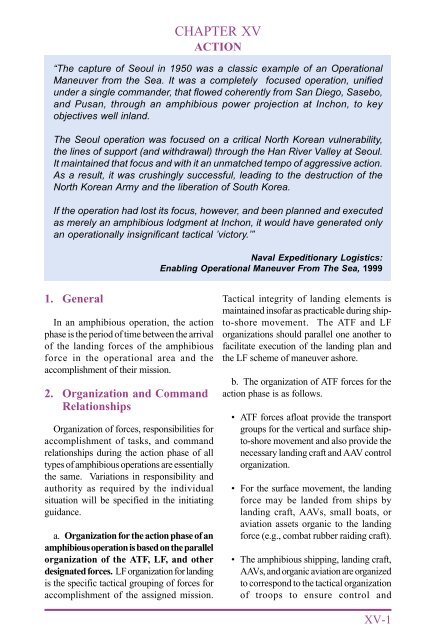Joint Doctrine for Amphibious Operations - Historic Naval Ships ...
Joint Doctrine for Amphibious Operations - Historic Naval Ships ...
Joint Doctrine for Amphibious Operations - Historic Naval Ships ...
- No tags were found...
You also want an ePaper? Increase the reach of your titles
YUMPU automatically turns print PDFs into web optimized ePapers that Google loves.
CHAPTER XVACTION“The capture of Seoul in 1950 was a classic example of an OperationalManeuver from the Sea. It was a completely focused operation, unifiedunder a single commander, that flowed coherently from San Diego, Sasebo,and Pusan, through an amphibious power projection at Inchon, to keyobjectives well inland.The Seoul operation was focused on a critical North Korean vulnerability,the lines of support (and withdrawal) through the Han River Valley at Seoul.It maintained that focus and with it an unmatched tempo of aggressive action.As a result, it was crushingly successful, leading to the destruction of theNorth Korean Army and the liberation of South Korea.If the operation had lost its focus, however, and been planned and executedas merely an amphibious lodgment at Inchon, it would have generated onlyan operationally insignificant tactical ’victory.’”<strong>Naval</strong> Expeditionary Logistics:Enabling Operational Maneuver From The Sea, 19991. GeneralIn an amphibious operation, the actionphase is the period of time between the arrivalof the landing <strong>for</strong>ces of the amphibious<strong>for</strong>ce in the operational area and theaccomplishment of their mission.2. Organization and CommandRelationshipsOrganization of <strong>for</strong>ces, responsibilities <strong>for</strong>accomplishment of tasks, and commandrelationships during the action phase of alltypes of amphibious operations are essentiallythe same. Variations in responsibility andauthority as required by the individualsituation will be specified in the initiatingguidance.a. Organization <strong>for</strong> the action phase of anamphibious operation is based on the parallelorganization of the ATF, LF, and otherdesignated <strong>for</strong>ces. LF organization <strong>for</strong> landingis the specific tactical grouping of <strong>for</strong>ces <strong>for</strong>accomplishment of the assigned mission.Tactical integrity of landing elements ismaintained insofar as practicable during shipto-shoremovement. The ATF and LForganizations should parallel one another tofacilitate execution of the landing plan andthe LF scheme of maneuver ashore.b. The organization of ATF <strong>for</strong>ces <strong>for</strong> theaction phase is as follows.• ATF <strong>for</strong>ces afloat provide the transportgroups <strong>for</strong> the vertical and surface shipto-shoremovement and also provide thenecessary landing craft and AAV controlorganization.• For the surface movement, the landing<strong>for</strong>ce may be landed from ships bylanding craft, AAVs, small boats, oraviation assets organic to the landing<strong>for</strong>ce (e.g., combat rubber raiding craft).• The amphibious shipping, landing craft,AAVs, and organic aviation are organizedto correspond to the tactical organizationof troops to ensure control andXV-1
















